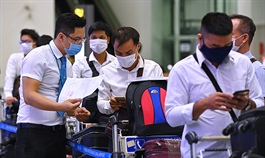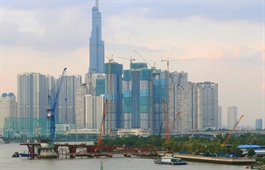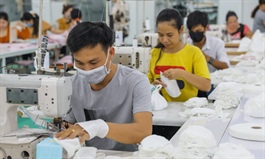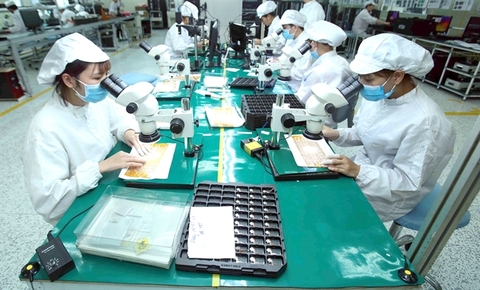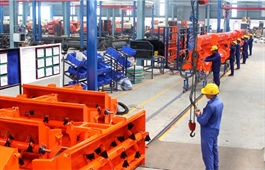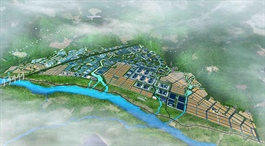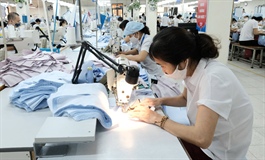Bac Giang province climbs up the ladder
Bac Giang province climbs up the ladder
With its great potential for sustainable growth, the northern province of Bac Giang is carrying out master planning focused on development of industrial zones and services sectors as key drivers to attract more funding. However, some more details would need to be clarified in the new arrangement.
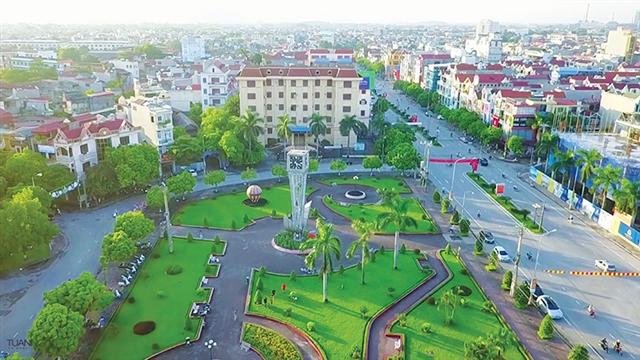
Bac Giang province climbs up the ladder
|
|
Plan for using land until 2030 - Allocation of land use: Until 2030, the province’s total natural land area will be approximately 389,600 hectares, including agricultural land (269,000ha, down by 32,500ha), non-agricultural land (119,800ha, up by 35,200ha); and as yet unused land (720ha, down by 2,670ha). - Withdrawal and transfer of land use purpose: Withdrawing 35,300ha including 35,040ha as agricultural land and 265ha as non-agricultural land. Changing the usage purpose of 35,040ha of agricultural land into non-agricultural land, in which large parts will be changed into land for national defence and security (925ha), industrial land (6,830ha), trade and services land (1,260ha), production and business land (1,020ha), infrastructure land (7,650ha), and household land (3,240ha). Development of urban areas - In 2020, the province had 16 urban areas including one type-2 city of Bac Giang, two type-4 urban areas of Thang and Chu towns, and 13 type-5 urban areas. - The urban population ratio in 2020 was 21.7 per cent. - The whole province will have five key urban areas for development: the central area (Bac Giang city and surrounding areas), the southern area (Bich Dong-Nenh and Nam Viet Yen towns), the western area (Thang and Nam Hiep Hoa towns), the southwestern area (Nham Bien town and the northwestern area of Yen Dung town), and a belt with ecological urban areas along the Cau River (Viet Yen-Hiep Hoa areas). |
The Ministry of Planning and Investment’s (MPI) Development Strategy Institute is supporting the authorities of Bac Giang in formulating the province’s master planning following a nod from the government as per the Law on Planning adopted by the National Assembly in 2018.
“This is expected to help Bac Giang attract more investment, especially foreign direct investment (FDI),” said Duong Van Thai, Secretary of Bac Giang Party Committee at last week’s meeting of the appraisal council of the province’s master planning for the 2021-2030 period, with a vision until 2050.
Covering nearly 3,900 square kilometres and boasting a population of 1.84 million people, Bac Giang’s economy grew on average 11.4 per cent during 2011-2020, and 14 per cent during 2016-2020. Its economic structure is held by industry and construction (58 per cent), service (22.2 per cent), agro-forestry-fishery (17.6 per cent), and others (2.2 per cent).
Under the draft master planning which will be adopted by the prime minister, Bac Giang will focus on developing industrial zones and clusters, services, and high-tech agriculture. Especially, the number of zones will increase from the existing six (1,645 hectares) to 29 (7,778ha) by 2030 – home largely to projects in electronics, other equipment, and garments. The number of clusters will also be raised from the existing 45 (1,728ha) to 66 (3,100ha) by the end of the decade.
The service sector will be centred on attracting projects in the sectors of logistics, transportation, trade, warehousing, and tourism.
The province will also be reorganised in development space and connectivity with other localities via 10 key gateways invested with key roads, general service areas, and warehouses.
“The province’s leadership is working with many foreign investors wishing to pour a huge sum of capital into industrial, services, and urban development,” Thai said. “Many investors have come to the province to implement their projects worth hundreds of millions of US dollars. For example, Apple has invested a $700 million project here to produce MacBook and iPad devices. This promises to help the province attract a new wave of tier-one high-quality vendors.”
According to a provincial draft report on master planning, FDI into the province has soared recently. “Bac Giang has been always listed among top FDI destinations of Vietnam. Many major foreign and local investors have taken interest in the province, such as Foxconn, CapitaLand, FLC, Tan Tao, and Lilama,” said the report.
In the first three months of 2021, Bac Giang licensed many projects registered at over $600 million, up over 4.5 times against in the same period last year. Almost all foreign-invested projects operate in industry sectors such as garments and textiles, electronic parts, and solar panels.
Notably, in January, the province licensed four foreign schemes. The first was the $270 million Fukang Technology factory from Foxconn Singapore to produce eight million tablets and laptops a year – raising Foxconn’s total investment in Bac Giang to $900 million. Foxconn is also expected to invest another $700 million in Bac Giang this year.
The second project was the $210 million Ja Solar PV Vietnam of Ja Solar Investment (Hong Kong) Ltd. to manufacture solar photovoltaic panels with total annual capacity of 3.5GW.
Third was the $75 million Risesun New Material Vietnam Factory from Risesun Investment Pte., Ltd. (Singapore) to produce plastics and composite products with total annual capacity of 46 million square metres. The final initiative licensed is the $6 million Kodi New Material Vietnam Factory, also from Risesun, to make coloured PVC decorative films with total annual capacity of 70 million sq.m.
Two weeks ago, Bac Giang established an office to attract investment from Japan and remove all obstructions for Japanese businesses.
In 2020, exports reached $11.12 billion, exceeding 71 per cent of the target set by provincial authorities. Bac Giang also approved new licenses and permitted additional investment to 215 projects registered at $1.4 billion, up 7.3 per cent on-year, rising to the ninth position among provinces and cities nationwide in FDI attraction. Provincial authorities are looking to attract $1.3 billion of investments in 2021 with prioritisation in high-tech projects using domestic materials.
Overall goals
Surrounded by major economic hubs, ports, national highways, and an international border, Bac Giang province is situated at the crossroads of major trade routes. It is located adjacent to the key economic triangle of Hanoi, Haiphong, and Quang Ninh, 110km from the Huu Nghi border gate with China, 100km from Haiphong seaport, and 40km from Noi Bai International Airport.
With its great potential, Bac Giang is now on the radar of investors. In its strategy partly featured in the draft master planning, the province aims to annually grow 15-16 per cent from 2021 to 2030 when it will become a modern province, and with a regional GDP listed in the group of Vietnam’s top 15 provinces and cities with the highest such rate.
The province aims to achieve an annual 13 per cent rise in labour productivity during by 2030, when it is expected to mobilise as much as VND1.5 quadrillion ($65.3 billion) worth of development capital.
As industrial land is increasingly occupied, Bac Giang has implemented several criteria to select investment projects: effective land use, less labour-intensive projects, advanced and modern tech projects, high-value addition, and contribution to the state budget. The provincial authorities have also decided to focus on high-tech projects such as electronics, machinery, and consumer goods, which are capable of joining global value chains and have high export potential.
With more industrial parks under development, the government is devising investor-friendly policies, in the hope of attracting high-tech investments. In addition, the government has also started to invest in the declining agriculture sector to develop high-tech farms and set priorities for investment in clean and renewable energy to meet rising electricity demand.
Regional competition
Bac Giang ranks as the 40th most competitive locality in Vietnam among 63 cites and provinces as per the Provincial Competitive Index (PCI) 2019. Meanwhile, under the Provincial Administrative Performance Index 2019, Bac Giang reached 81.84 points, up 3.7 points on-year, and the satisfaction index of people, enterprises, and organisations on administrative agencies reached 89.18 per cent, ranking ninth in Vietnam.
On the flip side, the province ranks poorly in auditing as investors find the process to be lacking in transparency and fairness.
Working to address the issue, Bac Giang People Committee has promised to increase transparency and efficiency in audits and other administrative activities by learning from the successful experiences of other localities. The province aims to jump to the top 15 rankings in the PCI for 2020.
Provincial authorities have also set up a 24-hour hotline to receive feedback from investors. Large foreign businesses can also register to meet with authorities to resolve business challenges.
According to a report from Bac Giang’s Master Planning Appraisal Council, which gathers comments from ministries and agencies that are members of the council, the draft master planning would need to clarify some points so that it can become more feasible and more attractive to investors.
“The province needs to supplement assessments on the implementation of some planning on agro-forestry-fishery development, and results from this sector’s restructuring; and also on the attraction of domestic investment and FDI in this sector, while also needing to point out difficulties and propose solutions to lure agricultural investment,” reads the report, which also suggests the supplementation of assessments on the sectors of logistics, tourism, and transport.
The draft master planning also needs to provide analysis on developing materials and supporting industries for key products. Analysis is also needed for human resources for industrial development, as well as for the development of labourers of factories at industrial zones, according to the MPI.




